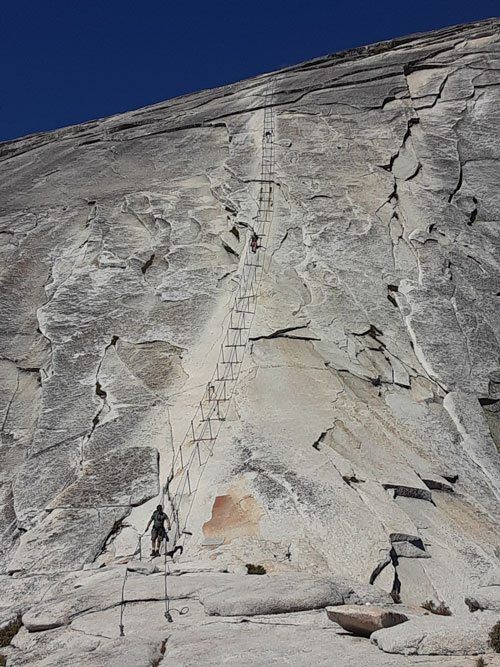
Multiple Half Dome day hikers have experienced various forms of heat-related illness over the past couple weeks—brief summaries of two of the incidents are as follows. In one case, having successfully summited Half Dome in the early afternoon, and with only a mile or so left to reach the trailhead, a subject in his mid-20s was unable to continue hiking due to severe cramping in both legs. A search and rescue team responded up the Mist Trail and brought the patient to the trailhead in a wheeled litter. Meanwhile, to help with rehydration, the paramedic on scene gave the subject intravenous normal saline; by the time the team reached the trailhead his condition had improved dramatically. In another case, a subject in his early 70s experienced intense muscle cramping in his legs while on the summit of Half Dome. Bystanders descended the cables and reported his condition to the ranger checking permits at the base of Sub Dome. By the time the ranger arrived at the top of the Half Dome cables, fellow hikers had given the subject water mixed with electrolyte tablets, and the subject reported that his symptoms were improving. The two descended the cables together. In fact, as the pair continued down Sub Dome, the ranger recalls, “I had trouble keeping up with him on the way down, as he was feeling better and moving rather fast.”
Additionally, last week, within a 24-hour span, Yosemite National Park emergency medical providers responded to three medical calls related to dehydration and heat exhaustion. In all three cases, the subjects had been hiking in the heat of the day. None had not been drinking adequate amounts of water while hiking. The three subjects reported various telltale signs and symptoms of dehydration and heat exhaustion: they felt dehydrated, fatigued and exhausted, hot and even feverish, and experienced nausea and vomiting. The subjects went hours and hours without urinating and when they did urinate, the urine was dark yellow.
These incidents all provide a good opportunity to review tips for staying strong and healthy while hiking in the summer heat:
- Hike with—and drink—plenty of water. Eat salty snacks, or drink electrolyte beverages, to maintain a proper balance of electrolytes. Keep drinking water even after your adventure is over.
-
Pay attention to your output—if you go hours without visiting a restroom (or the woods!), your body needs more fluids.
-
Rest frequently in the shade, especially during the heat of the day. Consider soaking a bandana or buff with water and putting it around your neck to help cool your body.
- Consider wearing sun-protective clothing and a hat to avoid sunburn and keep you cool.
-
Avoid stimulants and alcohol before, during, and immediately after a strenuous hike or other outdoor activity.
-
Half Dome: No matter how fit you are, the Half Dome hike is very strenuous. The suggested minimum amount of water intake for hiking Half Dome is 1 gallon (4 liters) per person. Equally important is ensuring you are maintaining a good electrolyte balance. Keep moving around the summit once you’ve reached the top, or if you plan to rest for a longer period, stretch before and after.
